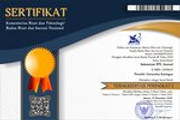FOSTERING STUDENTS’ ENGAGEMENT IN SYNCHRONOUS LEARNING USING INTERACTIVE WEB-BASED MEDIA
Abstract
This research was conducted to investigate the implementation of BookWidgets to facilitate the students’ engagement in synchronous learning through web-conferencing. The subject were students of Al-Madina Vocational High School from 11 OTKP, which involved 29 students. The objective of this implementation was to foster the students’ engagement during synchronous class, to find out the way BookWidgets facilitated the students’ engagement, and to reveal the most dominant students’ engagement types when BookWidgets was integrated. This study was a nested mix-method, employing observation, interview, and survey to gather the qualitative and quantitative data. It was applied for four meetings. The result of this research showed that this implementation could engaged students behaviorally, emotionally, and cognitively. They presented positive behaviors, involvement, effort, positive emotion, achievement, and good self-regulation during their learning. The interesting features had created meaningful learning for students in terms of verbal participation, students’ feeling and students’ academic investment. The easy use features of BookWidgets made students enthusiastic and reduced the boredom which made them motivate and engage in following the synchronous learning. Based on the statistical data, BookWidgets facilitated behavioral engagement with 78%, emotional engagement with 76%, and cognitive engagement with 75%. From this result, it could be seen that BookWigets mostly facilitated the behavioral engagement. Two or more engagement types were possible to occur simultaneously, but the level of each engagement could be different.
Keywords: students’ engagement; synchronous learning; BookWidgets.
Full Text:
PDFReferences
Alioon, Y., & Delialioglu, O. (2019). The effect of authentic m-learning activities on student engagement and motivation. British Journal of Educational Technology, 50(2), 655–668. https://doi.org/10.1111/bjet.12559
Alsied, S. M., & Pathan, M. M. (2016). The use of computer technology in EFL classroom: Advantages and implications. International Journal of English Language & Translation Studies, (January 2013).
Amin, F. M., & Sundari, H. (2020). Efl students’ preferences on digital platforms during emergency remote teaching: Video conference, lms, or messenger application? Studies in English Language and Education, 7(2), 362–378. https://doi.org/10.24815/siele.v7i2.16929
Astuti, L., Wihardi, Y., & Rochintaniawati, D. (2020). The development of web-based learing using interactive media for science learning on levers in human body topic. Journal of Science Learning, 3(2), 89–98. https://doi.org/10.17509/jsl.v3i2.19366
Creswell, J. W. (2014). Research design: Qualitative, quantitative, and mixed methods approaches. In SAGE (4th ed.). Retrieved from http://marefateadyan.nashriyat.ir/node/150
Faoziah, O., Jubaedah, I. S., Kodir, Ab., & Syarifah, E. F. (2020). The use of ICT in EFL classroom. Journal of English Language Learning (JELL), (103). Retrieved from http://download.garuda.ristekdikti.go.id/article.php?article=1123449&val=12697&title=THE USE OF ICT N EFL CLASSROOM
Francescucci, A., & Rohani, L. (2019). Exclusive synchronous online (VIRI) learning: The impact on student performance and engagement outsomes. Journal of Marketing Education, 41(1), 60–69. https://doi.org/10.1177/0273475318818864
Francis, J. (2017). Technology on student motivation and engagement in classroom-based learning (Doctoral Dissertation, University of New England). Retrieved from http://dune.une.edu/theseshttp://dune.une.edu/theses/121
Fredricks, J. A., Blumenfeld, P. C., & Paris, A. H. (2004). School engagement: Potential of the concept, stte of the evidence. Review of Educational Research, 74(1), 59–109.
Kennedy, G. (2020). What is student engagement in online learning … and how do I know when it is there? In Melbourne CSHE Discussion Papers. Retrieved from https://melbourne-cshe.unimelb.edu.au/__data/assets/pdf_file/0004/3362125/student-engagement-online-learning_final.pdf
Leavy, P. (2017). Research design: Quantitative, qualitative, mixed methods, arts-based, and community-based participatory research approaches. New York: The Guilford Press.
Lee, E., Pate, J. A., & Cozart, D. (2015). Autonomy support for online students. TechTrends, 59(4), 54–61. https://doi.org/10.1007/s11528-015-0871-9
Luthfiyyah, R., Aisyah, A., & Sulistyo, G. H. (2021). Technology-enhanced formative assessment in higher education: A voice from Indonesian EFL teachers. EduLite: Journal of English Education, Literature and Culture, 6(1), 42. https://doi.org/10.30659/e.6.1.42-54
Menon, S. A. (2019). Designing online materials for blended learning: Optimising on book widgets. International Journal of Linguistics, Literature and Translation (IJLLT), 2(3), 166–174. https://doi.org/10.32996/ijllt.2019.2.3.19
Perdue, D. S. (2016). How technology can increase student engagement and mathematics and mathematics understanding. (March).
Perveen, A. (2016). Synchronous and asynchronous e-language earning: A case study of virtual university of pakistan. Open Praxis, 8(1), 21–39. https://doi.org/10.5944/openpraxis.8.1.212
Rahayu, D. (2020). Synchronous zoom web conference system: An exploratory study on students’ e-learning experience. Journal of ELT Research (JER), 5(1), 80–93. https://doi.org/10.22236/JER
Rajabalee, B. Y., Santally, M. I., & Rennie, F. (2020). A study of the relationship between students’ engagement and their academic performances in an eLearning environment. E-Learning and Digital Media, 17(1), 1–20. https://doi.org/10.1177/2042753019882567
Taspinar, B., Schmidt, W., & Schuhbauer, H. (2016). Gamification in education: A board game approach to knowledge acquisition. Procedia Computer Science, 99(October), 101–116. https://doi.org/10.1016/j.procs.2016.09.104
Amin, F. M., & Sundari, H. (2020). Efl students’ preferences on digital platforms during emergency remote teaching: Video conference, lms, or messenger application? Studies in English Language and Education, 7(2), 362–378. https://doi.org/10.24815/siele.v7i2.16929
Thomas, D. (2020). Factors explaining active vs inactive users of elearning in a blended context among univeristy students in Thailand. ASEAN Journal of Education, 6(1)(September), 28–35. Retrieved from https://www.researchgate.net/publication/344324764_Factors_Explaining_Active_vs_Inactive_Users_of_eLearning_in_a_Blended_Learning_Context_among_University_Students_in_Thailand
Wang, M., Cheng, B., Chen, J., Mercer, N., & Kirschner, P. A. (2017). The use of web-based collaborative concept mapping to support group learning and interaction in an online environment. Internet and Higher Education, 34, 28–40. https://doi.org/10.1016/j.iheduc.2017.04.003
Yuwanda, D. Y. (2017). The use of choral drilll technique to improve students speaking skills (Thesis, State Institute for Islamic Studies Salatiga). Retrieved from http://e-repository.perpus.iainsalatiga.ac.id/2102/1/GraduatingPaper.pdf
DOI: https://doi.org/10.25134/ieflj.v8i1.5583
Refbacks
- There are currently no refbacks.

This work is licensed under a Creative Commons Attribution-ShareAlike 4.0 International License.

